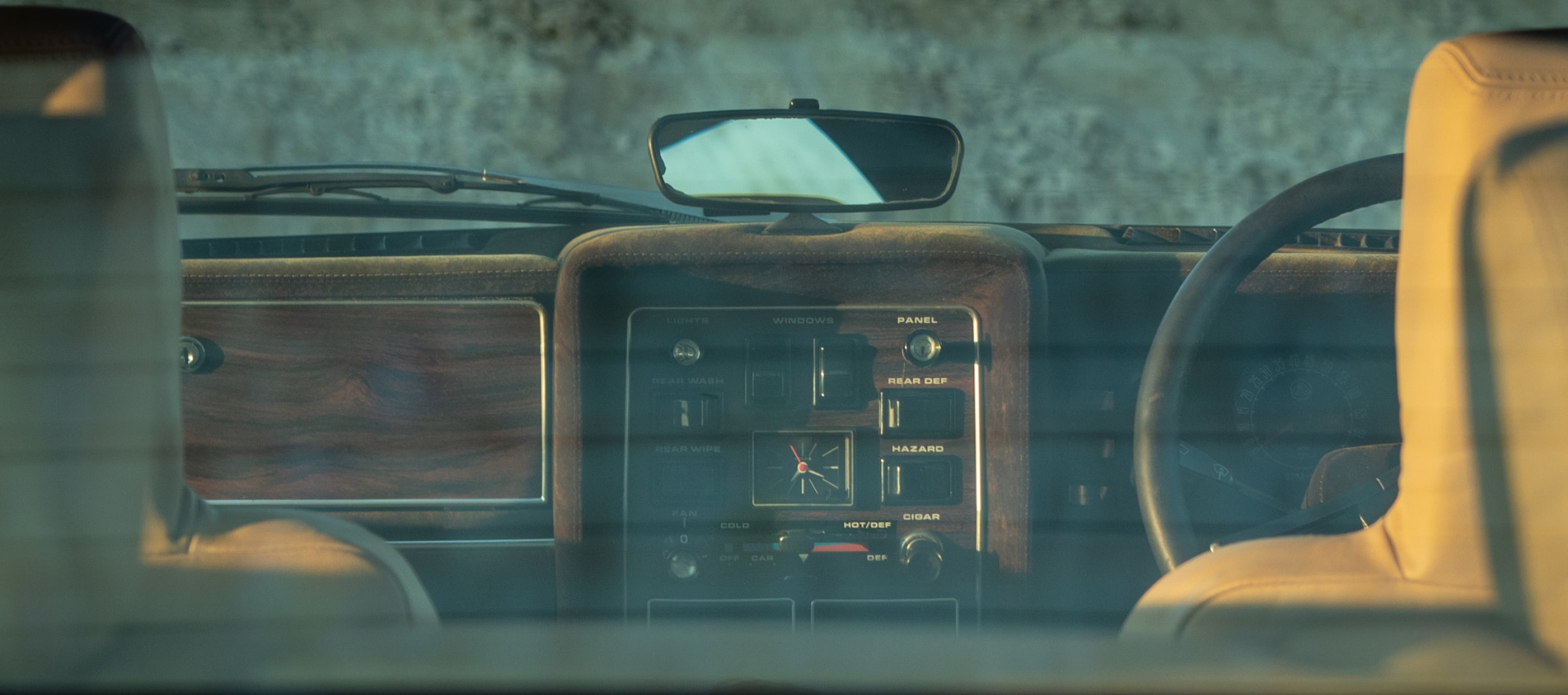
FIND YOUR PLACE IN LOTUS HISTORY
Since Lotus was founded in 1948, every year has been action-packed. With our interactive timeline, you can rewind history to your year of birth, and discover exactly what Lotus was doing.
1948

Lotus founder Anthony Colin Bruce Chapman studied structural engineering at University College in London. He built his first trials racing car in a lock-up belonging to his girlfriend’s parents. Using only a power drill and elementary panel beating skills, he crafted the 1930s Austin Seven based special into what later became known as the Mark 1 Lotus.
Chapman graduated in 1949, and after national service in the RAF, joined the British Aluminum company. This experience with aircraft technology, and the knowledge he acquired of aluminium was to have a significant impact on the Lotus ethos of “performance through lightweight”.
1950
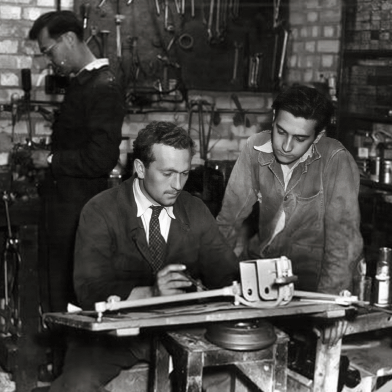
During his leave periods from the RAF, Chapman built his second trials car. This car was considered state-of-the-art and was the first Lotus to be usable on the road. It was sold in October 1950 to Mike Lawson, who quickly went on to win the Wrotham Cup.
Many theories have been formed over the years as to the origins of the naming of Lotus, but these can only be conjecture. The truth died with Chapman.
1951
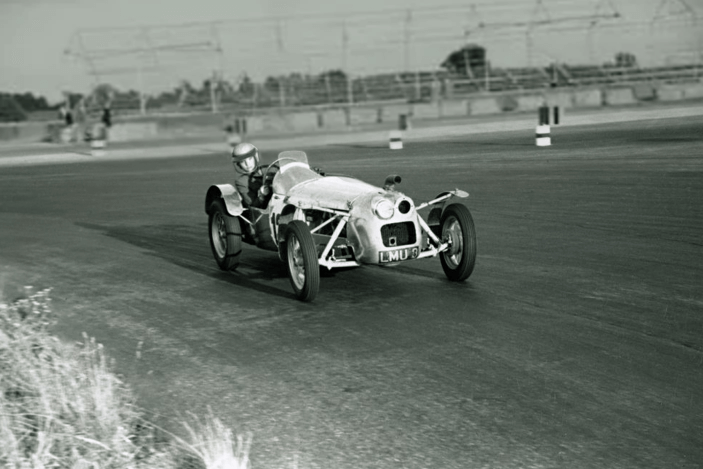
The first Lotus circuit racing car was designed – the first to actually be called a Lotus. The combination of the lightweight aluminium body and Chapman’s engineering expertise helped propel the car from 0-50mph in 6.6 seconds and reach a top speed of 90mph.
This was the true birth of the Lotus brand, although the two earlier cars were later known as the Mark 1 and 2.
1952

With the loan of £50 from girlfriend Hazel Williams, Chapman formed the Lotus Engineering Company. Build of the light-bodied Mark 4 began, but production of the space-framed Mark 6 racer soon overtook it. Over 100 Mark 6s were made over two years, and this became Lotus’ first series production car.
1954
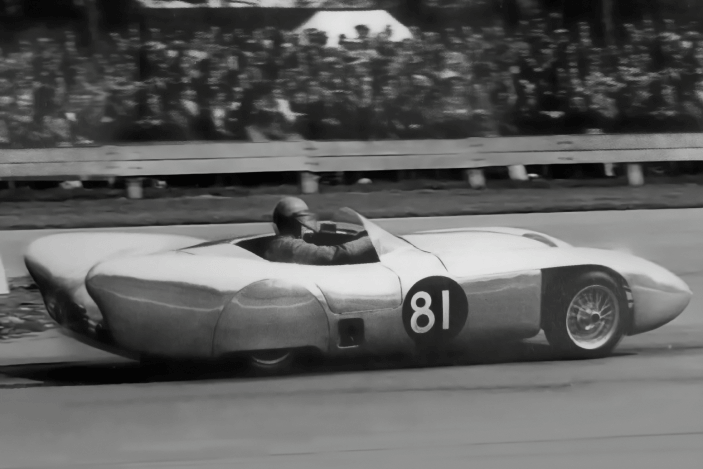
Entering international motor racing with the Lotus Mark 8, Team Lotus became an overnight success. On the racing scene, Chapman’s tendency to innovate and seek loopholes in the regulations begins, kindling his reputation as an industry maverick.
1956
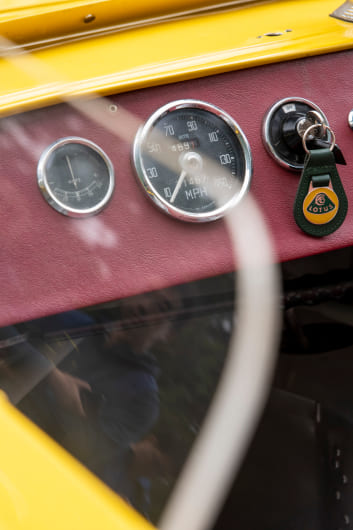
After a busy 1955, Chapman decided to focus development on one model for the following year.
A descendant of the Mark 9, the Lotus Eleven (Chapman’s chosen name and the start of the Lotus ‘E’ name tradition) came in three basic models to suit varying customer requirements. The Lotus Eleven proved highly successful on the race track, and achieved a historic win in the 750cc Class of the Index of Performance at Le Mans.
From here, Lotus models are referred to as types rather than marks.
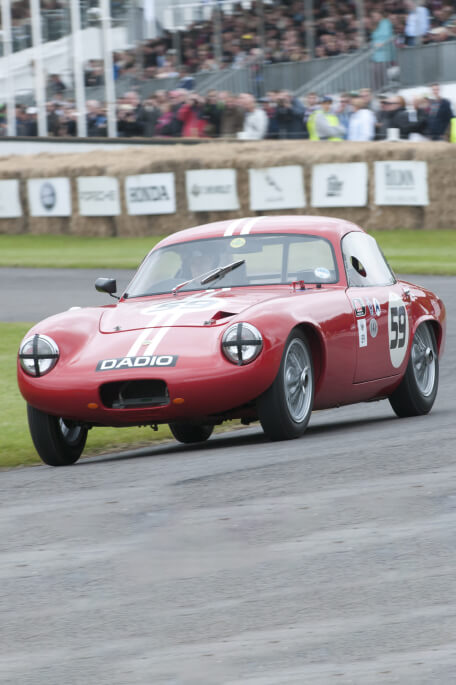
1957
The Lotus Seven was launched as a ‘no-frills’ sports car. The car was available as a kit or fully assembled, and delivered exceptional performance at a relatively low cost. Production of the Seven continued until 1973, when the rights were passed to Caterham, who still produce a version of the car today.
The Type 14 Elite was shown for the first time at the Earls Court Motor Show. This fixed head coupe is considered to be one of the best proportioned cars ever built. This was the first Lotus to use a glass fibre composite body that also acted as the chassis.

1958
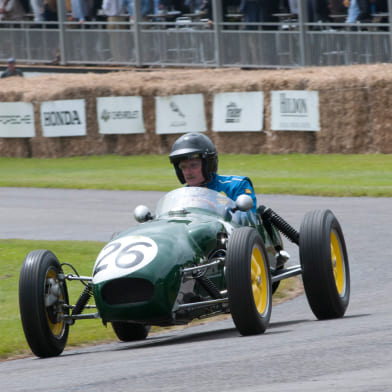
Chapman established Group Lotus.
Despite having been designed for Formula 2, the performance of the Lotus 12 meant that it became the first Lotus to enter Formula 1, winning fourth place at Spa.
The Type 15 (based on the Eleven), and Type 16 Formula 1 and 2 racing cars were developed. In one of the first engineering consultancy roles, Chapman had a hand in developing the Vanwall Grand Prix car for Tony Vandervell – which went on to win the 1958 Constructors Championship.
1959
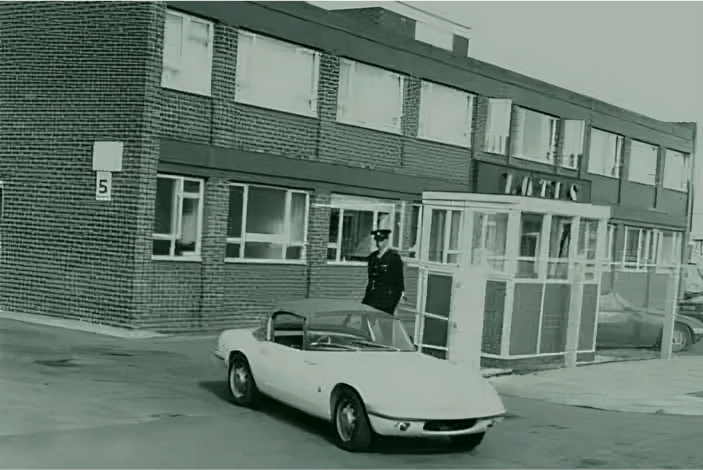
The factory moved from its original showroom on Tottenham Lane, London, to a new purpose-built facility at Cheshunt.
Following the success of the Lotus Eleven, a new small capacity sports racer labelled the Type 17, was developed. This car weighed just 341 kg, but proved unsuccessful on track and Chapman was forced to go back to the drawing board.

Lotus makes its mark on the swinging sixties.
1960
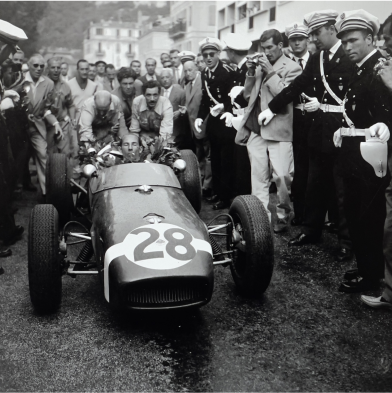
Chapman adopted and improved upon the mid-engined layout of the successful Cooper race cars to create the Type 18. The Type 18 was so competitive in Formula 1 and 2 that it was emulated by the majority of other cars. Stirling Moss drve the Type 18 in Monte Carlo, in the first of many championship Grand Prix wins.
Chapman regarded the Type 18 as the first true Formula 1 car he had designed. The Type 19 large capacity sports racer was developed from the Type 18 and dominated its class in the USA.
1961
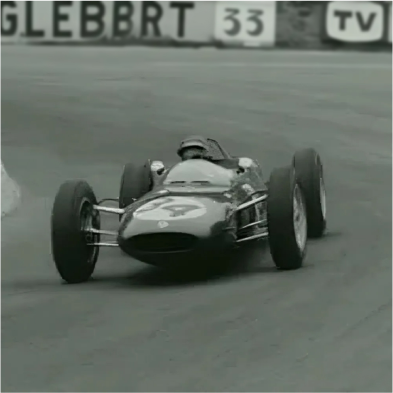
Demonstrating the ‘can do’ attitude of Team Lotus, the Type 21 was designed and built in only 6 weeks to compete in the 1961 Formula One season. The Type 21 was the first F1 car to use a reclining driving position and was the first Team Lotus car to win a world Championship Grand Prix, with Innes Ireland taking first place at Watkins Glen, USA.
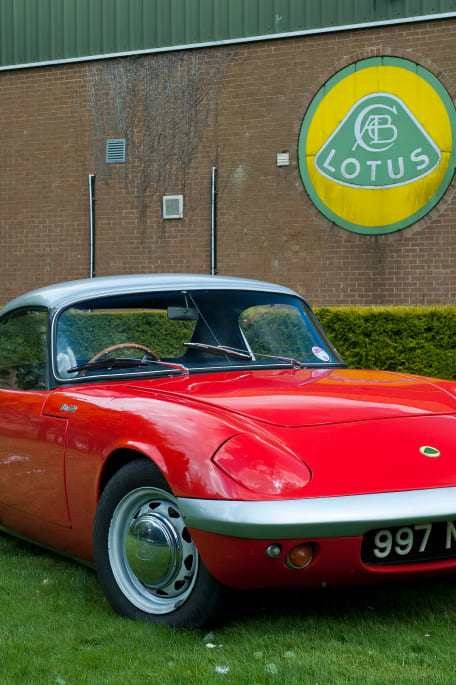
1962
Lotus introduced the Type 24 with a conventional chassis at the start of the F1 season, but it was soon eclipsed by the Type 25 which used a revolutionary fully stressed ‘monocoque’ chassis. The car won four F1 races in its first year, just missing out on the Championship.
The Type 26 Lotus Elan was introduced and rapidly became a standard by which other sports cars were measured. The car continued in production for 11 years due to its timeless design and popularity.

1963
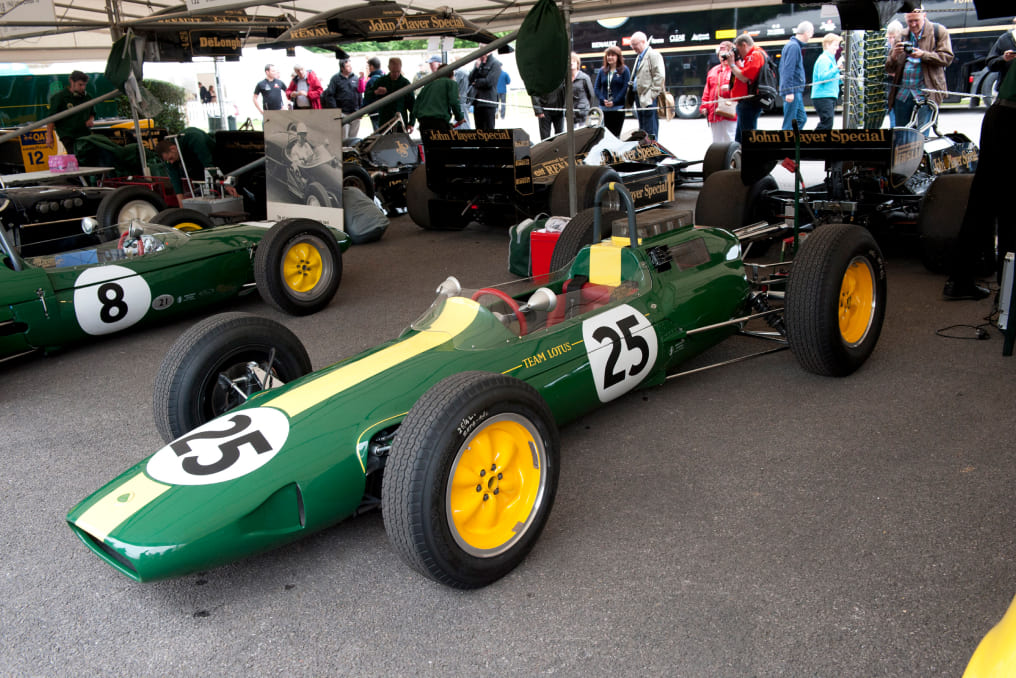
Lotus assisted Ford in the British Saloon Car Championship by developing the Type 28 Lotus Cortina. Chapman also developed his first Indianapolis car, the Type 29. After leading the Indy 500 in it for 28 laps, Jim Clark finished in second.
But with Jim Clark driving the Type 25, Lotus secured its first Formula One Constructors’ Championship, and the Drivers title. This was also the first Drivers’ World Championship for Clark, winning seven out of ten races. Both titles were won with maximum points.
1964
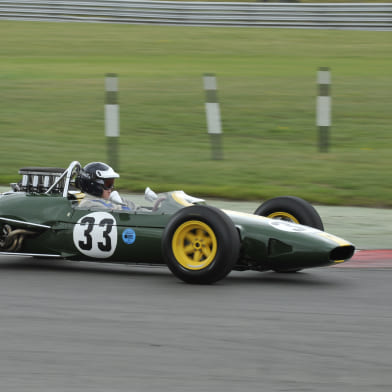
Lotus developed the Type 30, their first car designed for Group 7 racing. The Type 31, 32, and 33 were developed for Formula 3, 2 and Tasman, and 1 respectively, with the Type 33 evolving the monocoque Type 25 design.
1965
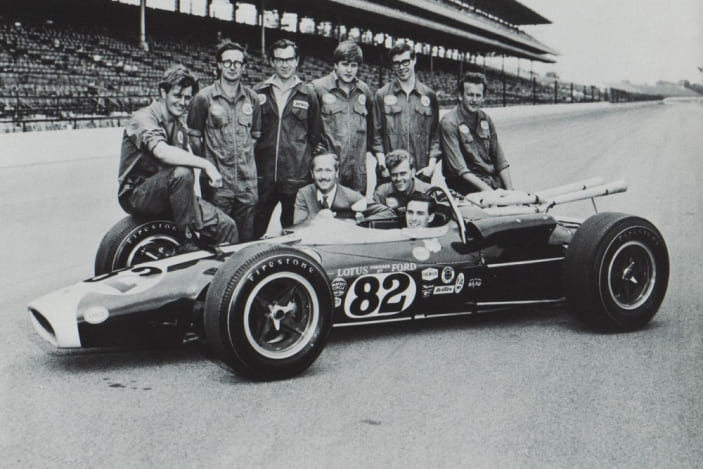
Jim Clark brought home another double for Team Lotus, winning both constructors’ and drivers F1 championships, this time at the wheel of the Type 33.
Clark also won the famous Indy 500 race in the USA in the new Type 38 averaging 150.686mph – a new record.
Type 36 Lotus Elan fixed head coupe made its debut as the first ‘luxury’ Lotus Coupe.
1966

Lotus moved to a purpose-built factory based in Hethel, Norfolk. Built on a former US Air Force base covering 55 acres, the old runways were converted into a 2.5 mile test track.
The Type 43 made its debut at Reims. It was the first F1 car to use the engine as a structural member. The enhanced Type 45 Elan S3 drophead sports car made its debut, followed by the mid-engined Europa (Type 46) road car, whose handling received considerable praise.
1967
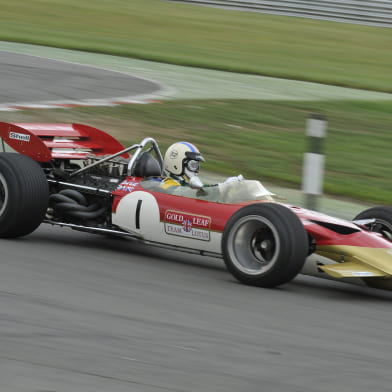
The Type 49 Formula 1 racer was the first car powered by the legendary Cosworth-Ford DFV V8 engine, which dominated the Formula 1 scene for over a decade. Jim Clark won the Dutch Grand Prix in the 49, and took pole position in the following 11 Grand Prix races.
The more spacious Type 50 Elan +2 went into production, with a longer chassis and different bodywork, enabling two people to be carried in the rear seats.
1968
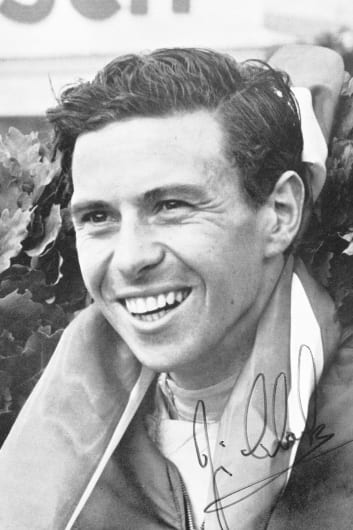
1968 proved to be a tragic year for Team Lotus with the loss of Jim Clark in a Formula 2 race at Hockenheim on 7th April. A black badge was added to Lotus cars as a sign of respect.
Chapman introduced the first commercial sponsorship onto the Formula One scene, and the Type 49 debuts the famous Gold Leaf livery of red, white, and gold – also sporting the first aerofoil wings in F1
1969
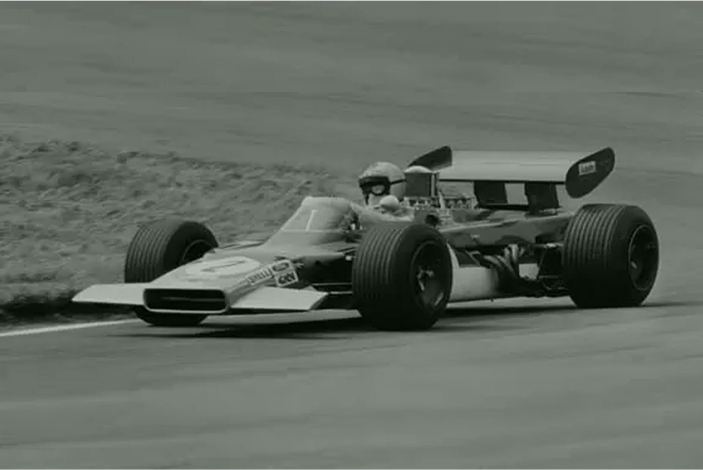
The new Seven S4 began production. Vastly different from its predecessor, the S4 was designed to be sold to the wider public through a new dealer network. The Seven S4 is designated Type 60 and used a chassis built from tubular steel with welded steel sides.
Following Europa’s success in the UK, Chapman decided to market the car in the US.
Meanwhile, the Type 63 became the first F1 car to use a wedge shaped front.

Team Lotus dominates the world of Formula One.
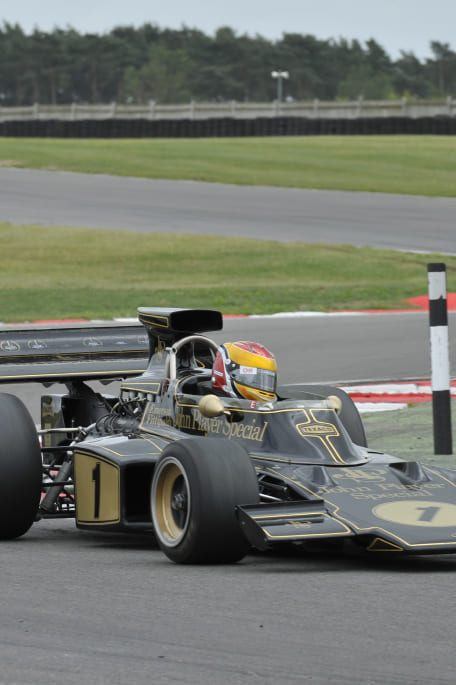
1970
Team Lotus unveils the innovative Type 72 F1 car that went on to achieve twenty grand prix wins. With inboard brakes, torsion bar springs, and the first use of mid-mounted, side radiators it was possible to create a car with a flat aerodynamic nose. It was also the first car to use a multi-element rear wing.
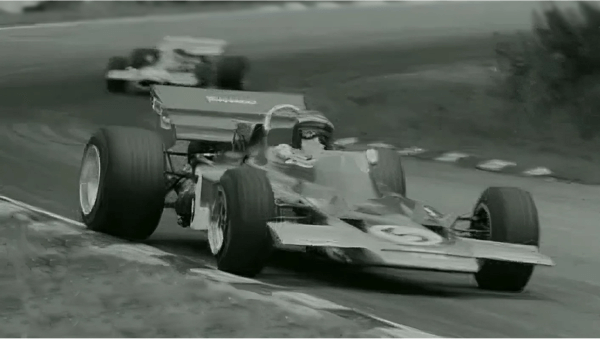
Austrian driver Jochen Rindt won the 1970 British GP at Brands Hatch in the Type 72. Victory came again in both the Constructor’s and Driver’s championships.
1971

Europa went on to realise its full potential with a change of engine and improvements to the handling, cabin space, and styling. It became one of the worlds quickest production sports cars.
1972

The Lotus Esprit concept, designed by Ital Design, was shown for the first time.
In the Type 72, now sporting the famous John Player Special livery, Emerson Fittipaldi won both Constructors’ and Drivers’ Championship.
The success of Team Lotus was reflected in the black and gold colour scheme available for the newly announced Europa Special.
1973
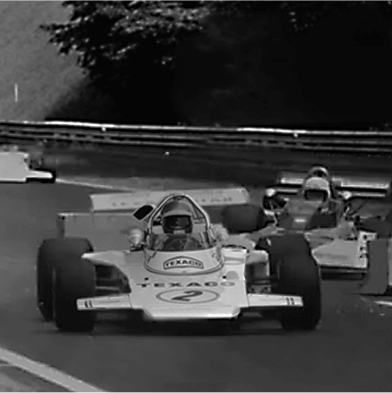
Lotus caused confusion by naming its next race car the Type 74, a type number already given to the Europa. Due to the sponsorship scheme on the car, the car became more commonly known as the ‘Texaco Star’.
Lotus won the Constructors Championship for the sixth time, and Emerson Fittipaldi comes second in the Driver’s Championship with Ronnie Peterson coming third.
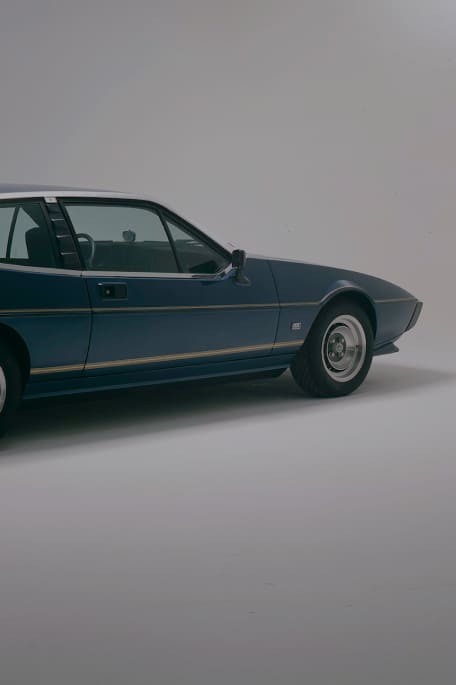
1974
Lotus’ first 4 seater sports car was launched, the Type 75 Elite. Though more luxurious than previous Lotus designs, the Elite still uses the company’s trademark backbone chassis.
The Elite’s glass fibre composite body used a Vacuum-Assisted Resin Injection (VARI) technology, demonstrating Chapman’s ceasless search for technical innovation, and transfer of knowledge from pit-lane to production.
1974 also saw the construction of the Type 76 Formula One car dubbed the John Player Special Mark 1.
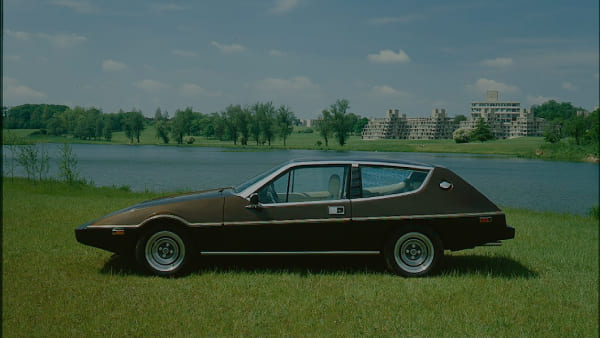
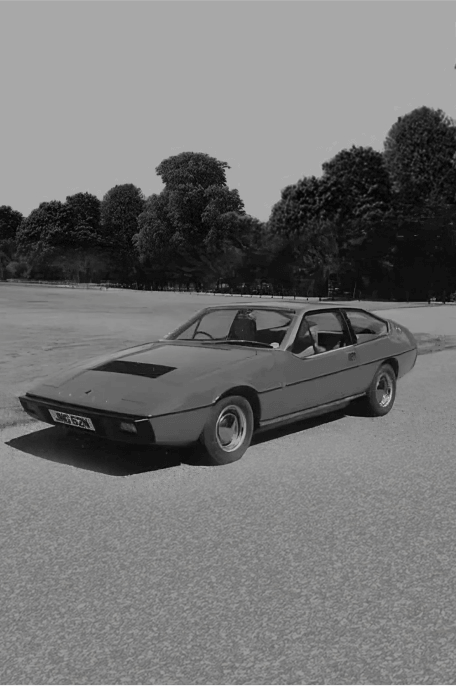
1975
At the Paris Motor show Lotus stunned the world with the premier of the dramatic Guigiario-styled Esprit (Type 79).
The Esprit was to reappear shortly afterwards at the London motor show, in company with the new 2+2 Eclat (Type 76). Both cars had glass fibre composite bodywork, steel backbone chassis, and were powered by the 2.0 litre Type 907 engine.
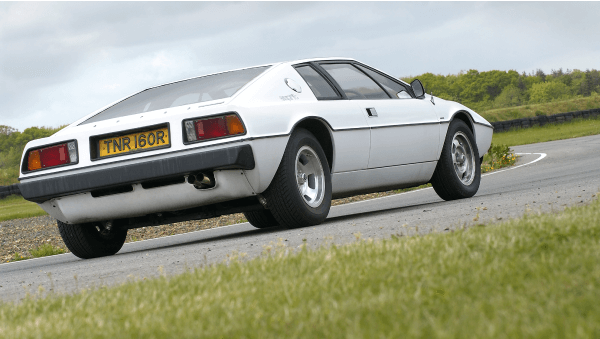
1976
The new Type 77 John Player Special Mark 2 was unveiled – the first car to incorporate adjustable suspension.
After a gap of two years without F1 wins, Lotus resumed its dominance with Mario Andretti taking the chequered flag in the rain at the Japanese Grand Prix.
This was the start of a phenomenal winning streak for Lotus.
1977

‘The name’s Bond… James Bond…’
Britain’s favourite spy had a fantastic new company car in the wedge shaped Esprit. The Esprit was the mechanical star of the Bond movie ‘The Spy Who Loved Me’, firing missiles and doing a memorable submarine impression.
Lotus continued its winning streak in F1 with the Type 78, the first car to manage airflow under the car. With five wins, Lotus took second place in the Constructors’ Championship.
1978
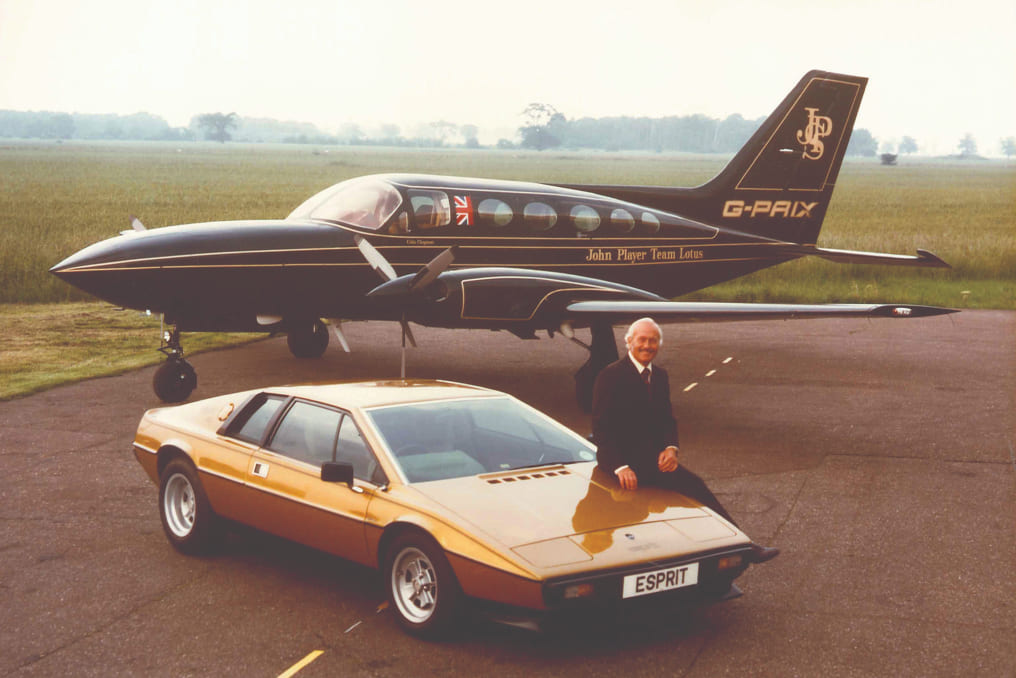
Team Lotus dominated Formula One – achieving 12 pole positions, and 8 wins, and yet another Constructors’ and Drivers’ double act. The Type 79, again proved Chapman’s genius for finding innovative engineering solutions.
The car was a development of the Type 78, which pioneered ‘ground effect’, harnessing the airflow under the car to suck it to the ground.
To mark this victory, Lotus produced 100 limited edition versions of the new Esprit S2, suitably liveried in JPS colours.
1979
The Type 80 “Wingless Wonder” F1 race car is introduced. A development of the World Championship winning Type 79, it took the ground effect concept to the another level by maximising the underwing area of the car and removing the drag-inducing topside mounted wings. However, following a number of poor results, it was retired from competition and the Type 79 was used for the remainder of the season.

Lotus engineers push the automotive envelope with breakthrough technologies.
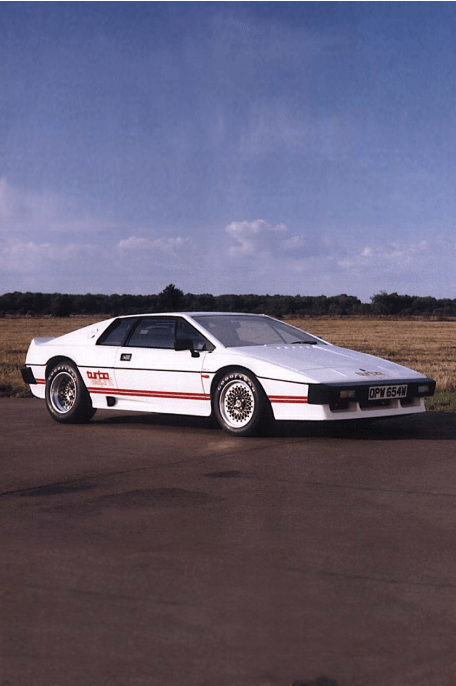
1980
The Esprit Turbo was launched in style at the Royal Albert Hall. Looking even more outrageous than the standard version, the Esprit Turbo boasted a galvanised chassis, new suspension, and a 210bhp 16-valve turbocharged 2.2-litre engine.
Its performance took it into the supercar league – 150mph+ and 0-60mph in 5.5 seconds. Other Lotus models were updated with the 2.2-litre engine and galvanised chassis, with the Elite and Eclat benefiting from new interiors, instrumentation, and switchgear.

1981
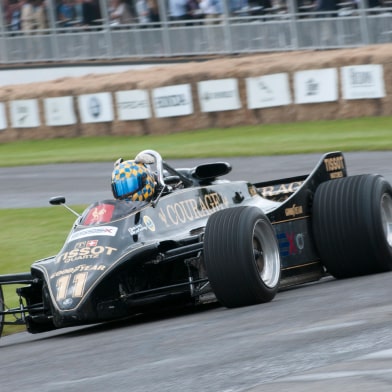
The Lotus Type 88 Twin Chassis Formula One car was the first car designed with a carbon fibre monocoque and two chassis – a softly sprung chassis for the driver, and a stiffer chassis for the mechanical components. This was eventually outlawed from competition by the governing body.
The Type 87 replaced it, and Nigel Mansell raced it alongside Elio de Angelis.
1981
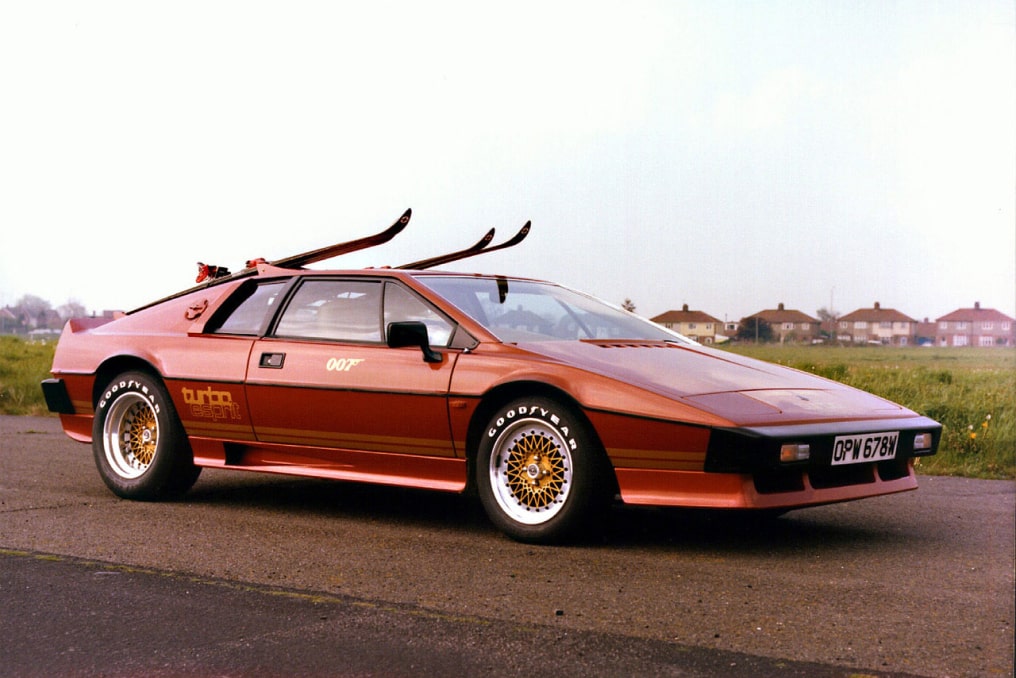
By incorporating the chassis and suspension of the Turbo into the non-turbo Esprit S3, Lotus was able to save costs on both models and passed this saving on to the customer.
In July the Esprit Turbo shot to stardom, featuring in the new Bond movie ‘For Your Eyes Only,’ which received another Royal Premier.
1982
With Elio de Angelis at the wheel, the Lotus Type 91 won its first Grand Prix Formula One race at the Austrian Grand Prix. This was to be the last win for Lotus in the Cosworth DFV engine.
1982
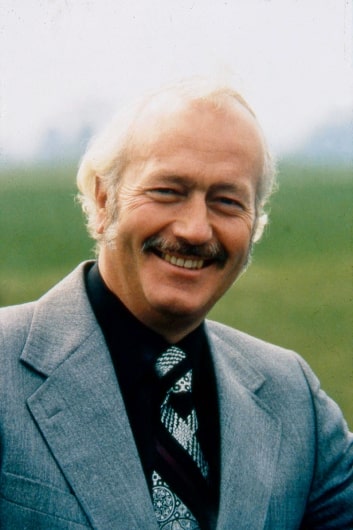
On Thursday December 16, Anthony Colin Bruce Chapman, founder and chairman, died suddenly from a heart attack at only 54 years of age.
1983
Chapman was greatly missed, but the spirit he imparted to his team and his colleagues lived on.
In May the Lotus Active Suspension System was announced. It used a pioneering system of computers to control the hydraulic suspension, maintaining balance throughout cornering, accelerating, braking, or traversing a bumpy surface. An experimental version of the Active Suspension system was tested on the Type 92 Formula One car, driven by Mansell.
1984
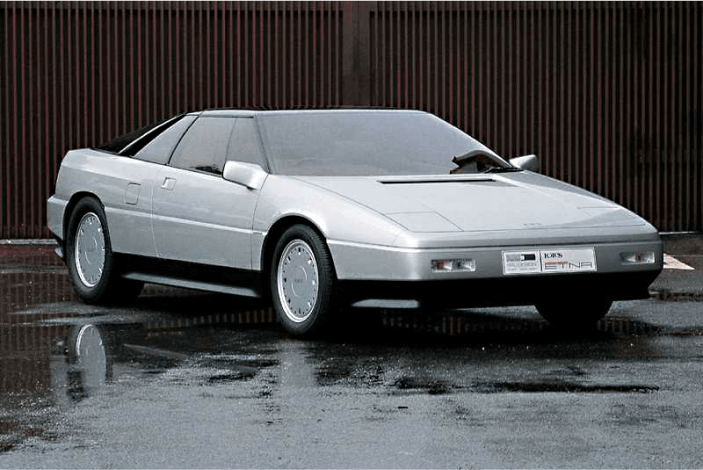
To demonstrate its commitment to becoming a major automotive engineering consultancy, Lotus opened two of the most sophisticated computer-controlled engine test cells in Europe.
The Hethel factory reached another milestone – 30,000 cars had been produced at the Norfolk factory since 1966.
The V8-powered Etna concept car, designed by Giugiaro, was shown at the British International Motor Show in Birmingham. The engine was Lotus’ own design, a 4.0-litre V8 developing 320bhp. Projected performance for the Etna was 0-60mph in 4.3secs, with a top speed of 180mph.
1985
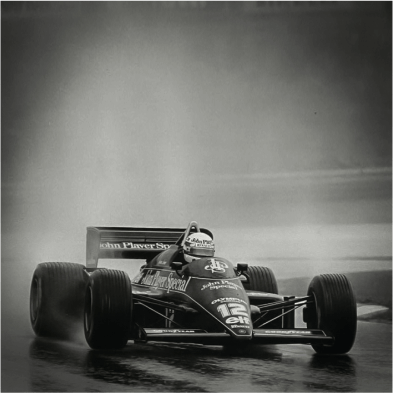
Ayrton Senna replaced the departing Nigel Mansell. In this first season, Senna drove the Type 97T, the first car to have aerodynamic barge boards. Senna won in Portugal, and again at Spa.
1987
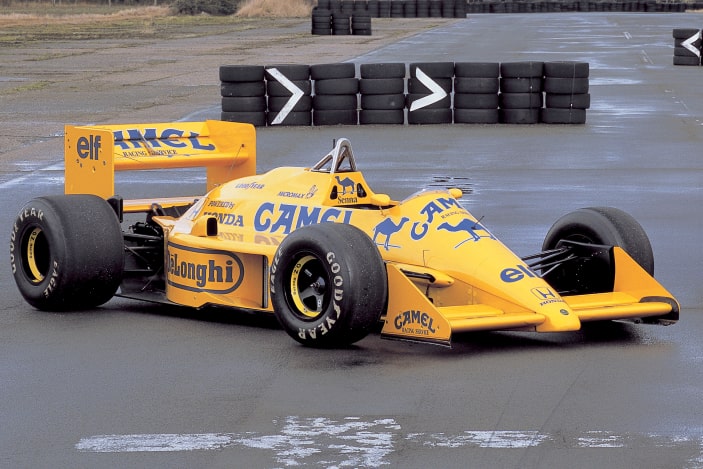
Camel became Team Lotus’ new major sponsor, and Honda the new engine supplier.
Ayrton Senna remained the team’s number one driver, and notched up wins at Monaco and Detroit in the Type 99T.
This was the first Lotus to adopt computer controlled active suspension. Senna proved its worth not just through his victories, but through 25,000 miles of rigorous testing and racing.
1987
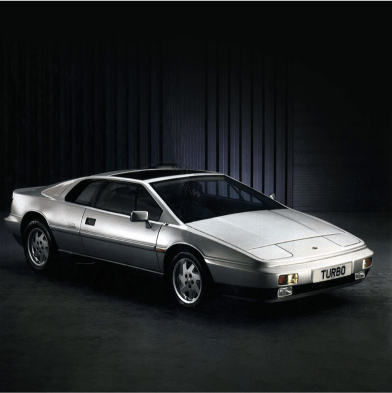
At the London Motorfair the new Esprit Turbo made its debut. Restyled by Peter Stevens, the car sported a more aggressive appearance, but retained its iconic stance. A standard model joined the line-up.
1988
Formula One World Champion, Nelson Piquet joined Lotus, following Ayrton Senna’s departure.
The 1988 Lotus Type 100T proudly wore the Number One of the reigning world champion.
1989
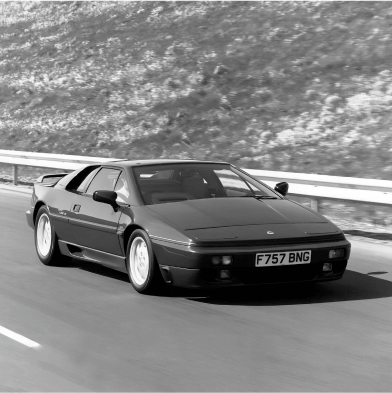
Lotus launched its most powerful supercar to date – the 264bhp, 164 mph Esprit Turbo SE, with a 0-60 mph time of just 4.7 seconds.
1989
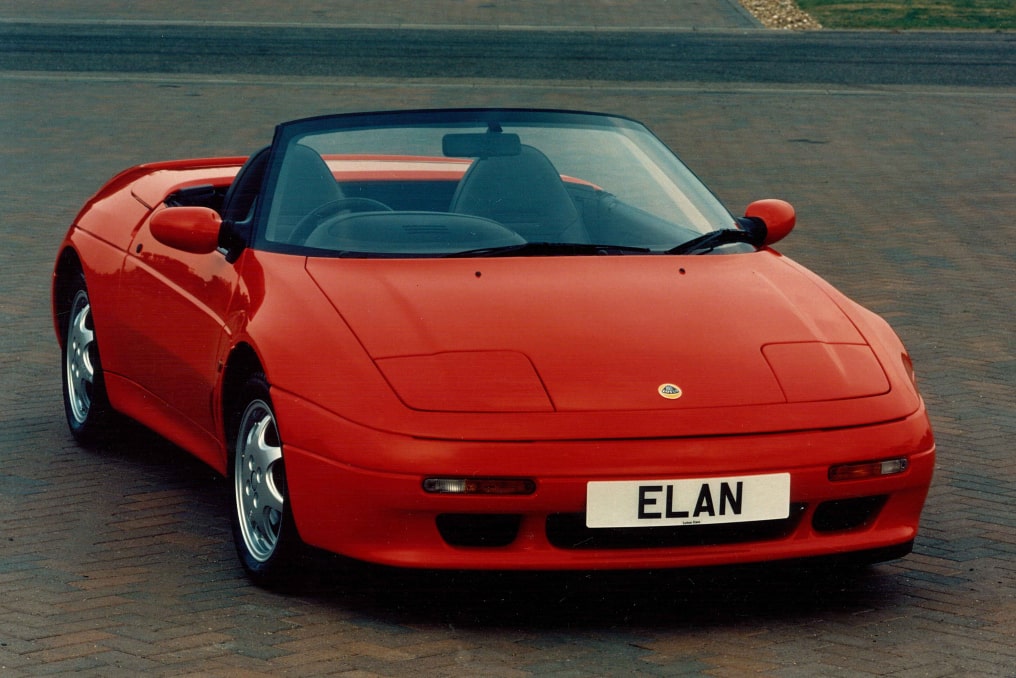
Lotus launched the Elan (Type 100) roadster at the London Motorfair.
Designed in-house the Elan broke with Lotus tradition by being front-wheel drive.
This was the first car to use the patented ‘Interactive wishbone’ front suspension set-up. It handled superbly and had exceptional levels of road holding.

Lotus celebrates the end of the century in style.
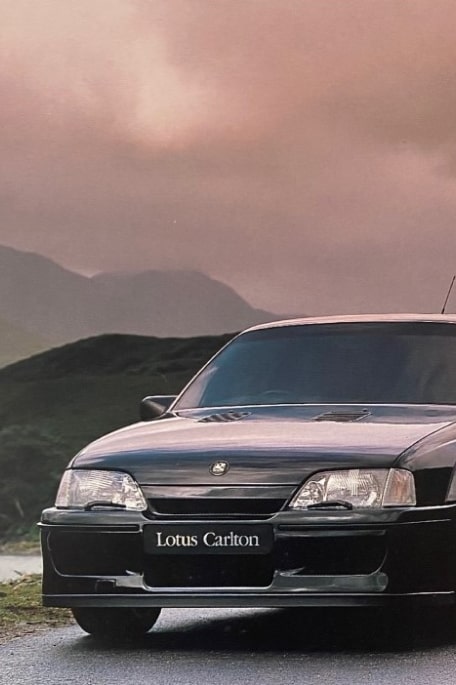
1990
The legendary Lotus Carlton (Lotus Omega outside the UK) was launched. Essentially a Carlton/Omega GSi stripped and rebuilt by Lotus, it was one of the quickest saloon cars in the world. Power came from a 3.6-litre straight-six with 24 valves and two turbochargers, producing 377bhp and 419lb ft of torque.
In magazine tests the Lotus Carlton hit around 174mph, and could manage 60mph in 5.2secs and 100mph in just 11.5secs.
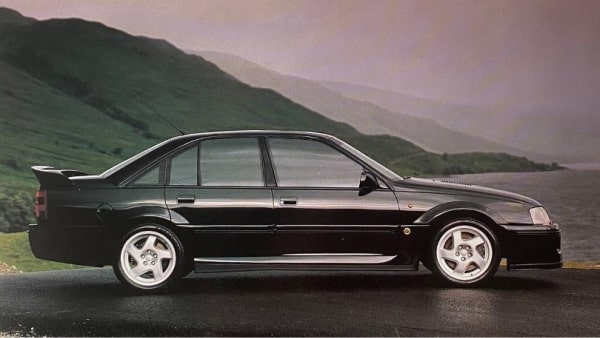
1991
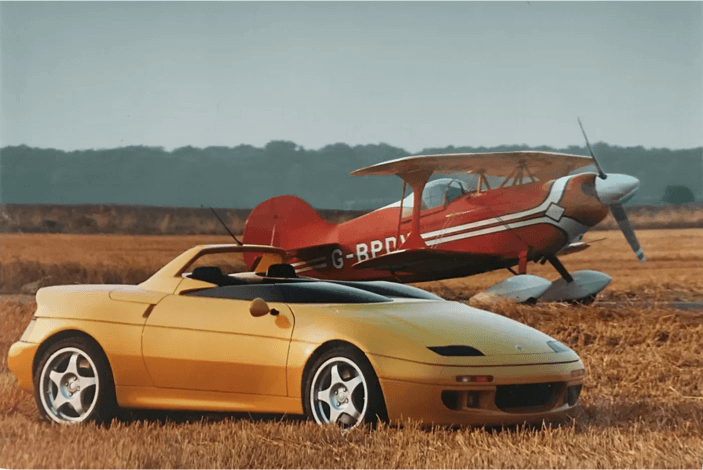
The M200, a futuristic concept sports car based on the Elan caused a stir at the Frankfurt Motor Show in September, and the following month a revised Esprit range was unveiled.
1992
Driving the Sport Esprit X180R, Doc Bundy took the Drivers’ title in the Sports Car Club of America World Challenge for ‘street-legal’ cars.
The X180R was produced as a limited edition in the US to make it eligible for competition – later that year it formed the basis of the Esprit Sport 300, the quickest Lotus supercar to date.
1992
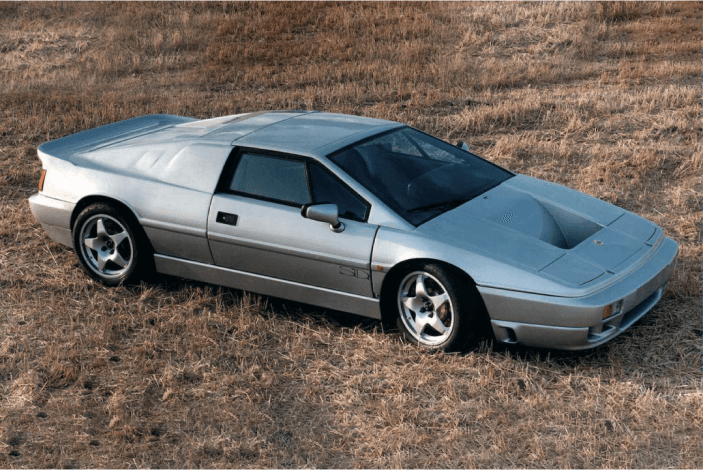
Lotus Engineering remained busy with the extraordinary ‘SID’ (Structure Isolation Dynamics) research vehicle, used to demonstrate some of the company’s experimental technology.
Some of that technology, ‘Lotus Active’ suspension, was fitted to an Alvis Scorpion tank – coupled with a track-tensioning device, this allows the Scorpion to travel at high speed while keeping its gun steady and not shaking its crew to pieces.
1993
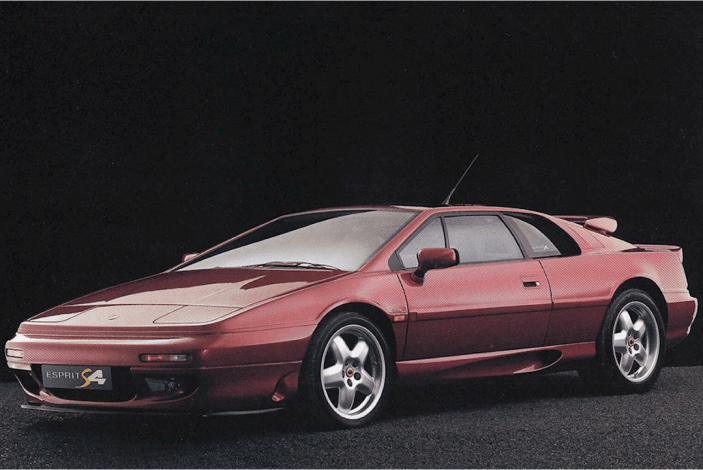
The Esprit S4 had a minor facelift and a range of mechanical refinements including power-steering as standard.
In May, the Esprit Sport 300 supercar went into production, and the following month a pair of them competed in the Le Mans 24-hour race – it was the first works-supported entry for more than 30 years.
1994
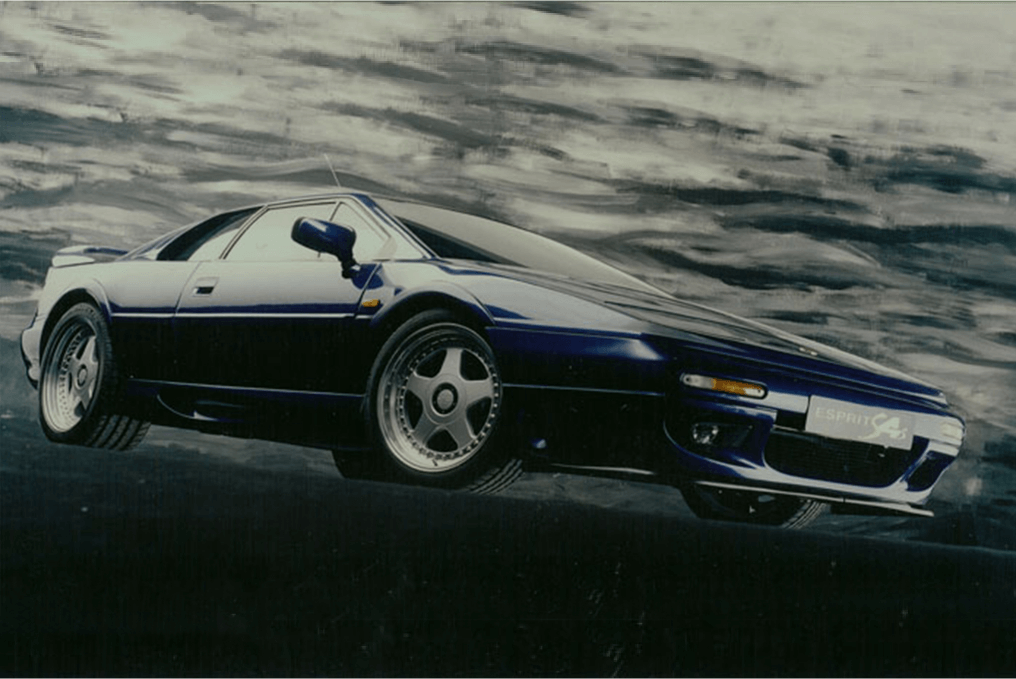
The Elan S2 was launched at the Geneva Motor Show. Featuring a new 16inch wheel and tyre package and some further suspension enhancements. The Elan S2 was to be built in a limited run of just 800 units.
Out on the race track, an Esprit Sport 300, driven by Thorkild Thyrring, won the British National GT series.
1995
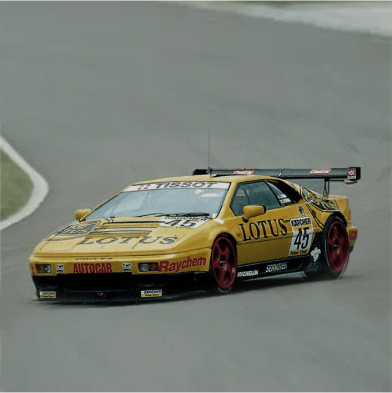
The Lotus GT race programme was brought in-house in preparation for an all-out assault on UK sports car endurance racing. In wet conditions at the Silverstone British Empire Trophy four-hour race, the team managed to take class honours and crossed the finish line fourth overall.
1995
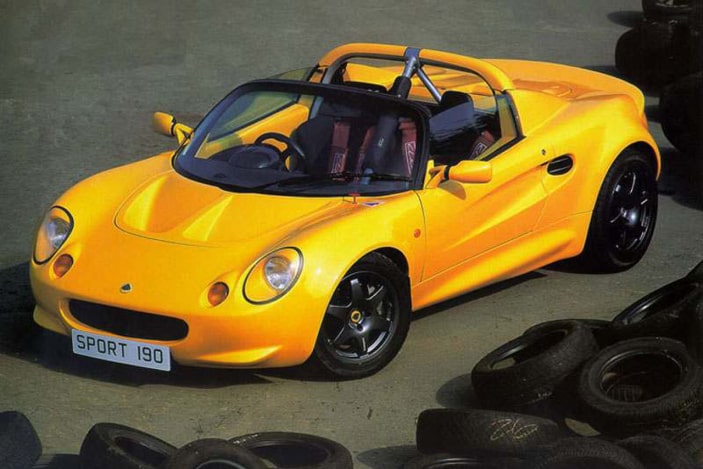
The Elise, (named after the granddaughter of Chairman, Romano Artioli), was unveiled at the Frankfurt Auto Show.
The Elise was not only pretty, it was technically advanced and super-light. Its composite and energy absorbing chassis was made from epoxy-bonded aluminium extrusions, a world first, as were its extruded aluminium suspension uprights and aluminium metal-matrix brake discs.
It delivered breathtaking performance (0-60mph in 5.8secs) for a price of less than £20,000.
1996
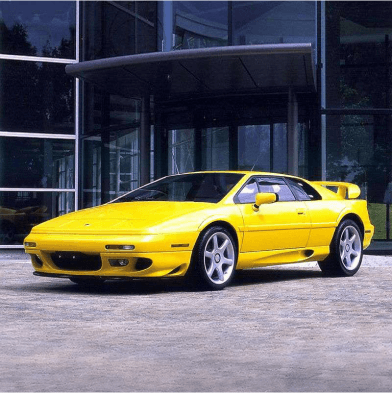
The all-new Esprit GT1 was unveiled at the Paul Ricard circuit in France on 1 March, the still-secret Lotus V8 lurking under its engine cover. Four days later the 175mph Esprit V8 road car made its debut at the Geneva Motor Show.
The extremely compact 3.5-litre V8 had twin turbos – not only did it deliver an impressive 350bhp, it had a whopping 400Nm of peak torque. The Esprit also benefited from upgraded brakes, featuring a new ABS controller and a new vacuum servo system.
1997
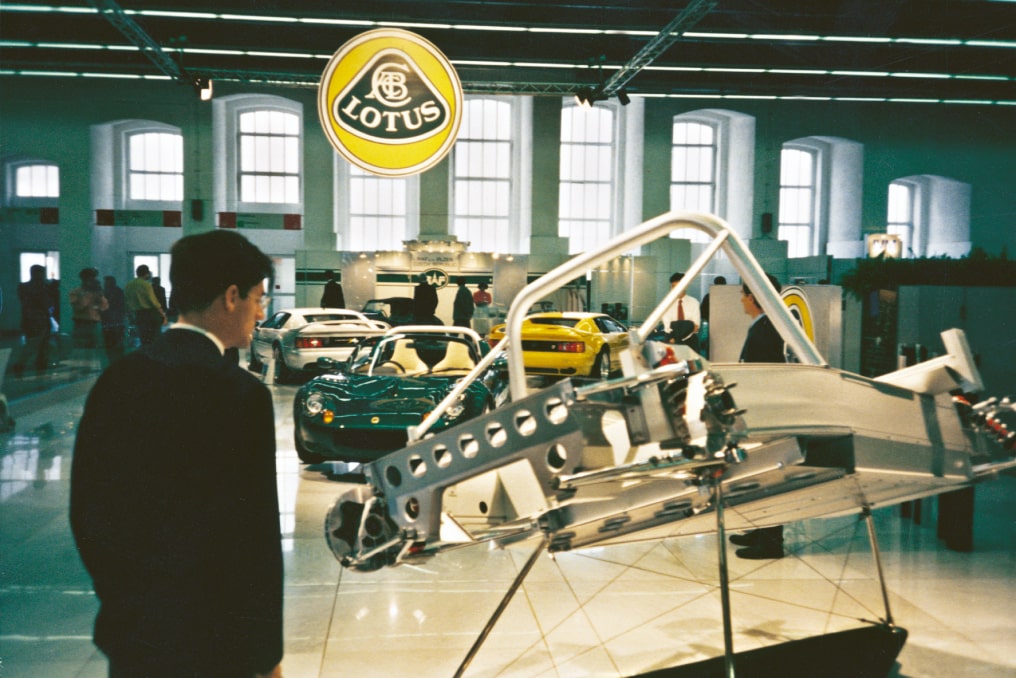
The Elise proved more of a hit than expected – the 1000th Elise rolled off the production line in the middle of May. Production was raised to 2500 units a year and two Elise versions were also unveiled. The first was a research project, powered by two Zytec electric motors, the second was the Sport 190, designed as a track day powerhouse.
1998

At the Birmingham Motor Show in October, Lotus revealed the stunning 340R as a concept car.
The lightweight and big-braked Esprit Sport 350 supercar was also released as a dramatic limited edition model.
1999
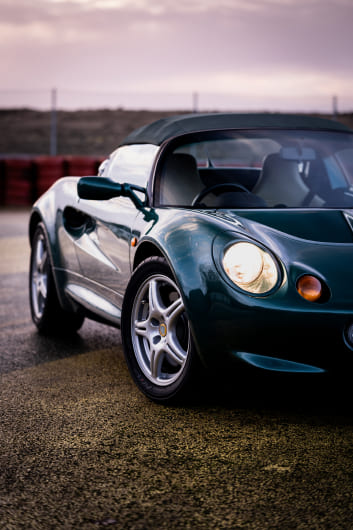
Lotus launched the Elise 111S at Geneva Motor Show in March.
Powered by a 145PS version of the 1.8-litre K series VVC engine, this sporty new derivative had a close-ratio gearbox and enhanced handling.
1999
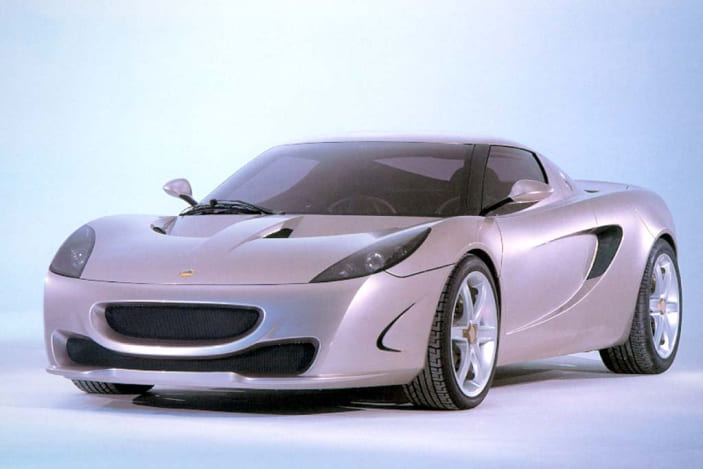
Lotus revealed an all-new mini-supercar concept that fitted into the range between the Elise and Esprit.
Called Project M250, the car had a 250hp, 3 litre V6 engine.

Lotus doubles down on research and development.
2000
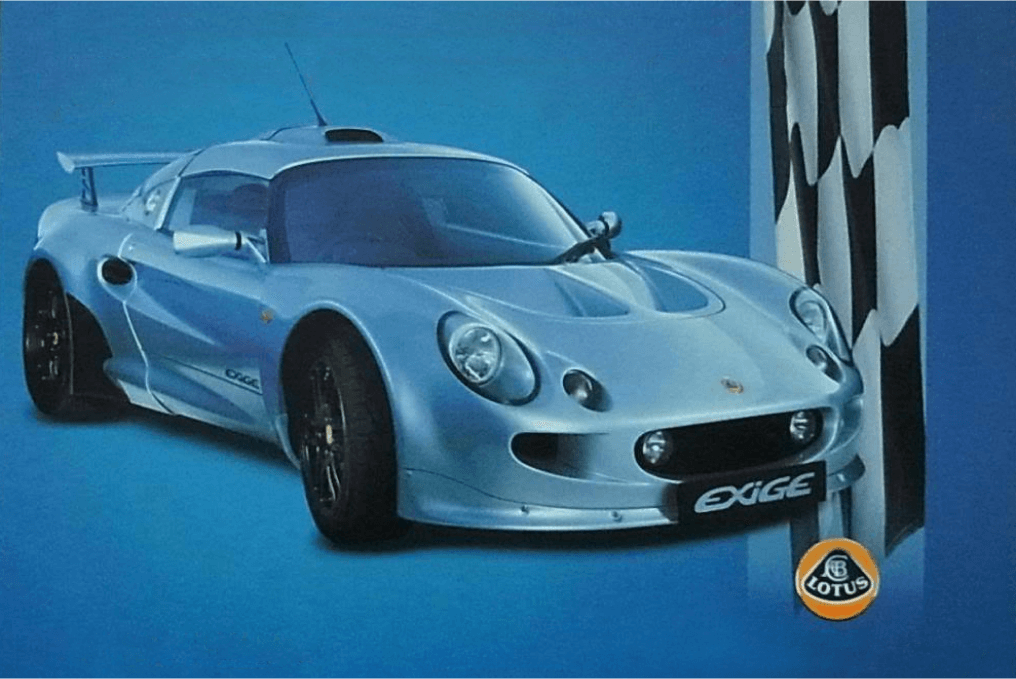
On the eve of the Autobytel Lotus Championship race series at Brands Hatch, Lotus thrilled the crowds by unveiling the new Exige. Styled on the Sport Elise racer, the Exige was an exhilarating yet well mannered road car, with the soul of a track car.
The new bespoke Research and Development Centre at Hethel opened in July, and Lotus Design was the first department to move in.
2002

Lotus Cars were awarded the Queens Award for Enterprise, for contribution to International Trade, one of just 85 companies receiving recognition in that category in 2002.
2003
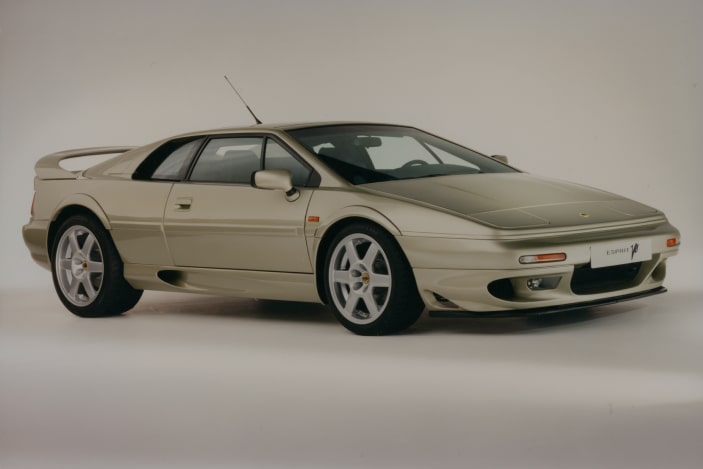
Late 2003 saw the last Lotus Esprit roll off the production line marking the end of over 27 years of production
2004
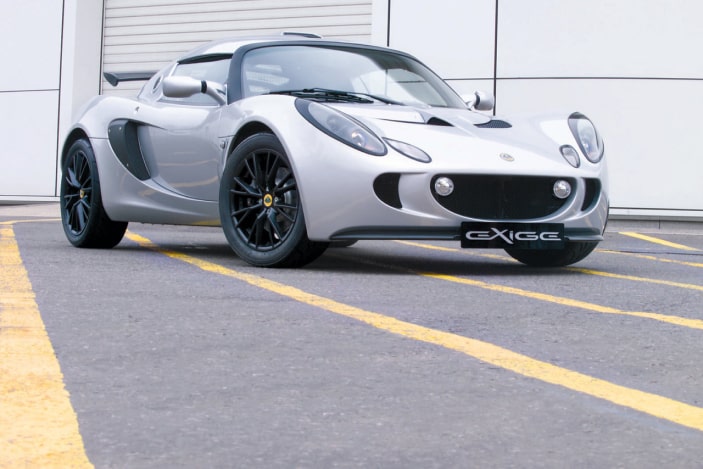
At the 2004 Geneva Show, Lotus presented the new Lotus Exige on the world stage. At the same event Lotus also launched a track version, the Lotus Exige Series 2.
Meanwhile, the 20,000th Elise is produced, making it the most popular Lotus car ever.
2005
The 400bhp 850kg GT2 specification Lotus Sport Exige, won the Petronas Primax 3 Merdeka Millennium 12 Hour Endurance race trophy at the International Sepang circuit, Malaysia on Sunday 27th August.
2006

At the Geneva motor show Lotus Engineering unveiled APX (“Aluminium Performance Crossover” ) vehicle, a fully running concept prototype embodying many of the technological philosophies Lotus had been following in its R&D programmes.
The Sport Exige GT3 secures victory in the 2006 British GT Manufacturers Championship, driven by George Mackinstosh and Sam Blogg.
2007
Lotus enters the Guinness Book of Records for the biggest meet of any marque when 311 Lotus sports cars turned up at Brands Hatch and formed a nose to tail lap.
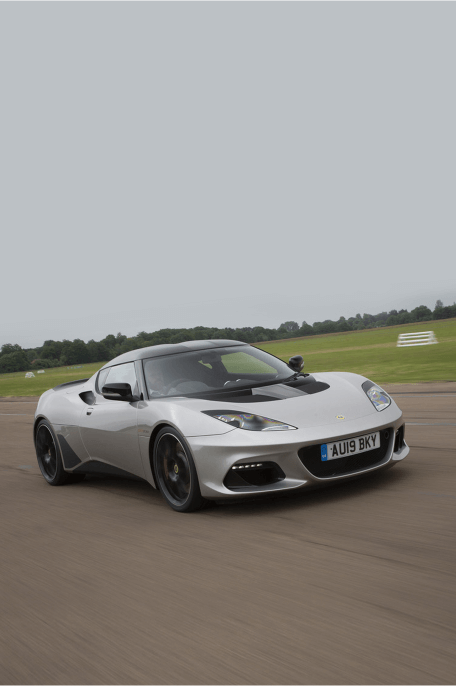
2008
The all new Evora is unveiled – the first all-new car to be launched by Lotus since the Elise made its debut in 1995.
The only mid-engined 2+2 on the market at the time, the Evora was powered by a Lotus-tuned 3.5-litre V6 engine producing 280 PS, and weighing just 1382 kg.
The Lotus Sport 2-Eleven GT4 Supersport race car asserted itself at the pinnacle of the 2-Eleven range, combining race winning pedigree with unparalleled handling and balanc
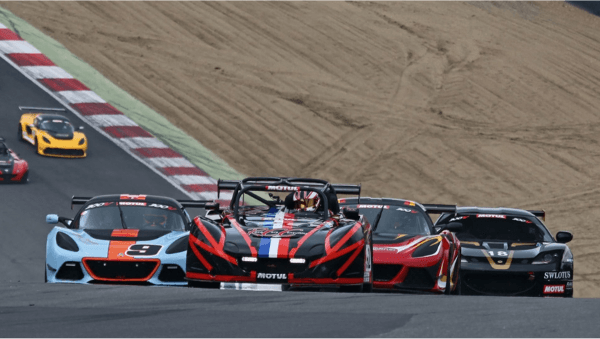
2009
Lotus Engineering unveiled the Range Extender engine at the Frankfurt International Motor Show in a series hybrid vehicle. The Range Extender engine was attached to an electricity generator and provided a highly efficient source of energy to power the electric motor directly or charge the vehicle battery. The battery could also power the electric motor which enabled the design of a drivetrain that has low emissions, and optimised performance.

Lotus shifts operations to a truly international scale.
2010
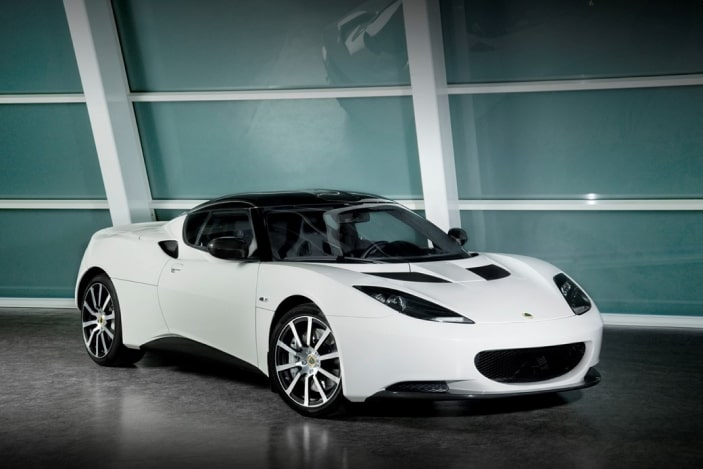
The Evora Carbon Concept was unveiled at the Geneva Motorshow. The pearlescent white body is complemented with a structural carbon fibre roof, Lotus motorsport influenced carbon diffuser and carbon front splitter, and finished with diamond-cut, forged alloy wheels.
At the International Geneva Motor Show, Lotus unveiled the Lotus Evora 414E Hybrid concept, a high performance technology demonstrator with a plug-in series hybrid drive system.
2010
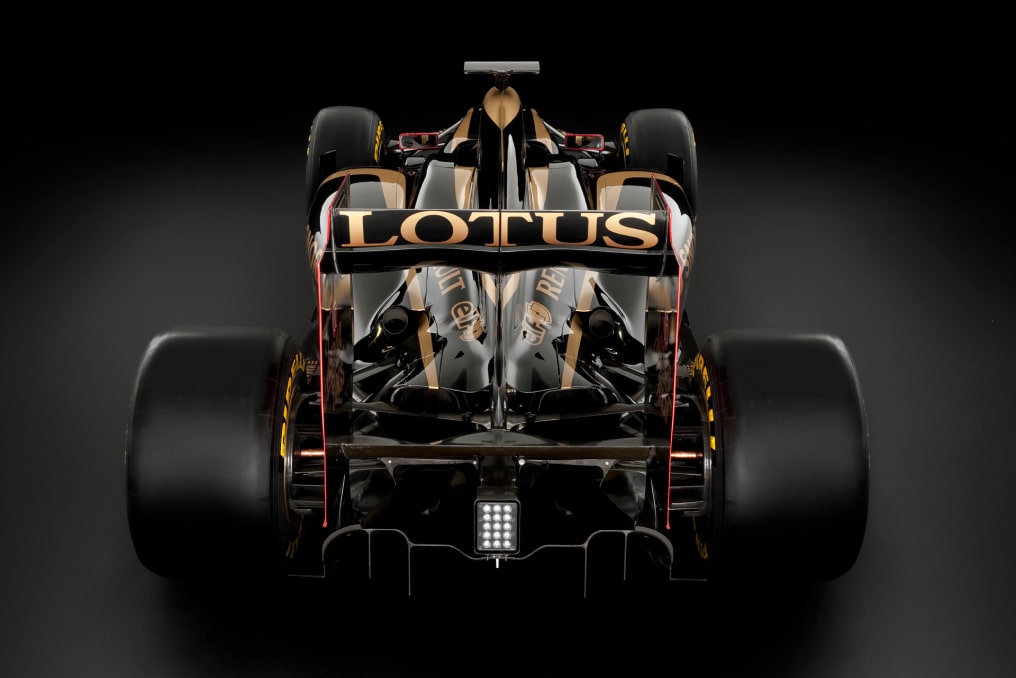
The iconic Lotus name returned to Formula 1 for the 2010 season after a more than 15 year long absence. It would continue to compete for 5 years with many highlights including wins in the 2012 Abu Dhabi and the 2013 Australian Grand Prix.
2011
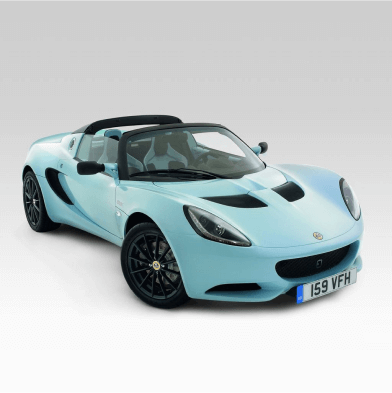
The Elise Club Racer is announced as a stripped-back, even more lightweight version of the Elise. Powered by the same 1.6-litre engine as the standard Elise, the Lotus engineers managed to reduce the weight of the Elise CR by 24kg over the standard Elise.
2011
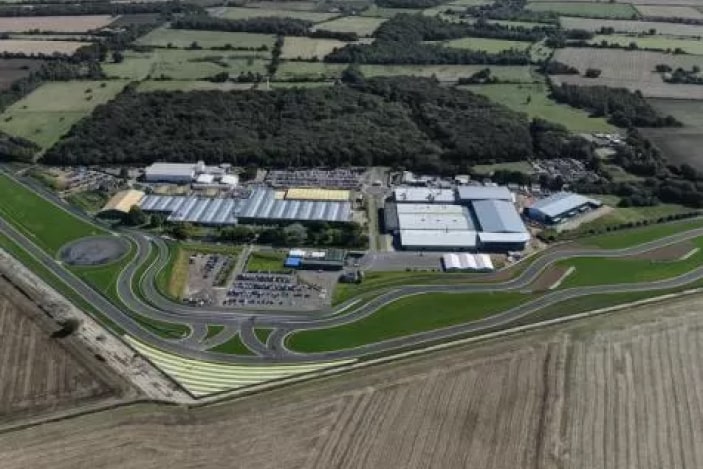
The Lotus test track at Hethel was renovated in 2011 and officially re-opened on 21 June at an historic event where both current and historic Lotus cars were driven around the new track by Nigel Mansell, Jean Alesi, Vitaly Petrov, Bruno Senna, Greg and Leo Mansell, Johnny Mowlem, and others.
2012
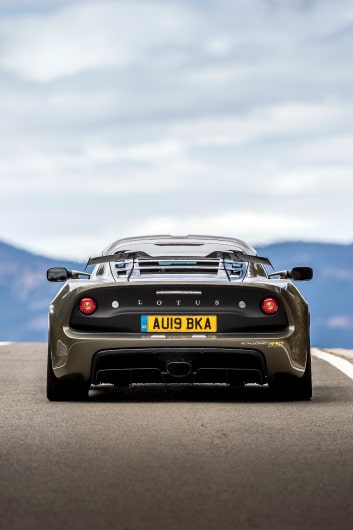
In true Lotus fashion, the Exige S Roadster's finely tuned suspension delivers a responsive ride and agile handling, while the supercharged 3.5 V6 engine with race-derived technologies delivers stunning performance – reaching 60 mph in 3.8 seconds.
2013
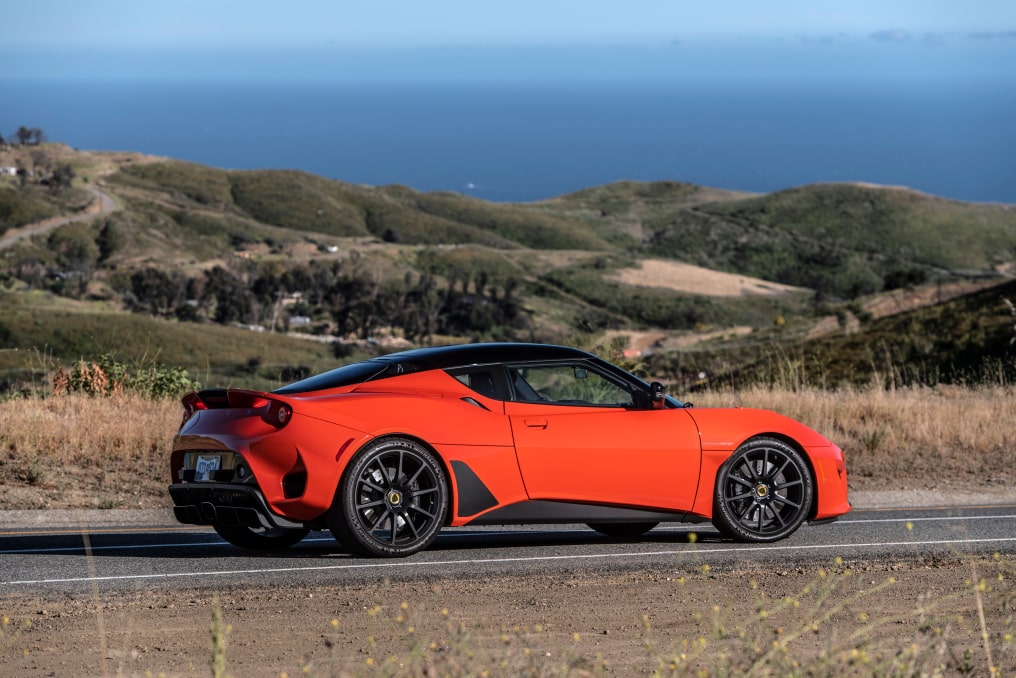
An optimised version of the mid-engined 3.5 litre Evora is launched, available in both naturally-aspirated or supercharged variants.
Four exterior colour options co-ordinate with contrasting accents of black across the roof, front splitter, side sills and rear diffuser, exaggerating the Evora’s aggressive stance, highlighting its sleek silhouette.
2014
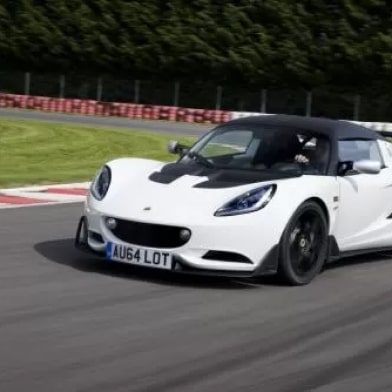
Ready for early press assessments, the Elise Cup S would be the most focused version of the still box-fresh Elise.
Its supercharged 1.8-litre engine would deliver soul-stirring acceleration, allied to its lightweight construction and a target to lap the Hethel test track quicker than ever.
2015
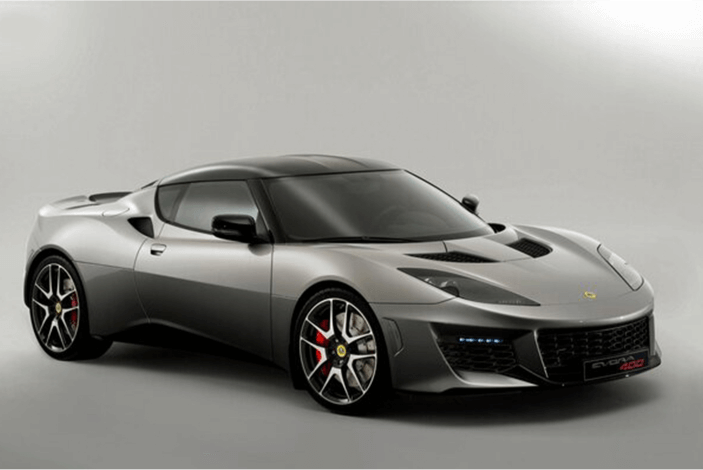
The Lotus Evora 400 was launched at the 2015 Geneva Motor Show as the latest supercar from Lotus, combining high performance with the legendary Lotus handling. It is faster and dynamically more capable than the previous Lotus Evora leading to greater agility and a more involving drive.
2015
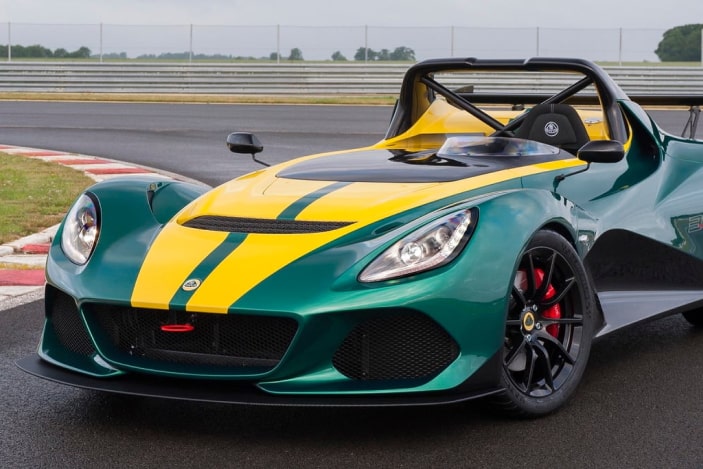
Heralding the next generation of Lotus high performance sports cars, the 3-Eleven is the company’s quickest and most expensive series production car ever. Designed to deliver an undiluted experience, the Lotus 3-Eleven utilised an all-new lightweight composite body, and a bespoke chassis based on the proven Lotus design of extruded and bonded aluminium sections.
2016

The fastest ever line up of Lotus production road cars was showcased at the 2016 Geneva Motor Show including the debut of the Exige Sport 350 Roadster as well as the Evora Sport 410 and Elise Cup 250 announced earlier in the year. With 250 hp powering 931 kg the Elise Cup 250 is the fastest Elise ever.
2016
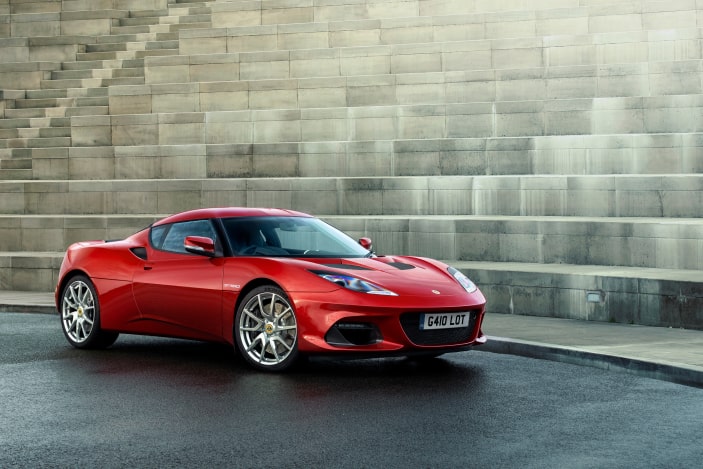
Lotus’ famous Lightweight Laboratory cut the weight of the Evora 400 by a massive 70kg. With a host of high-performance carbon fibre components as standard, and sharing the 410 hp supercharged engine with the track-bred 3-Eleven, the Lotus Evora Sport 410 clocked 0-60 in 3.9 seconds on its way to a top speed of 186mph.
2017
Geely Holding Group buys a 51% stake in Group Lotus.
2018
Geely announced Mr Feng Qingfeng’s appointment as CEO of Group Lotus plc in June, as Lotus celebrates its 70th anniversary.
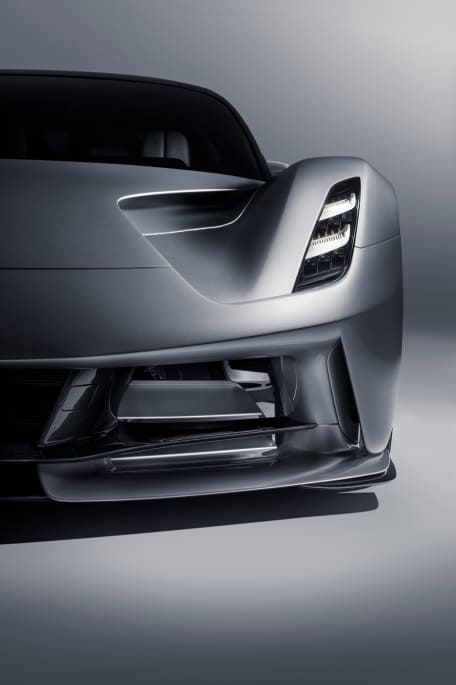
2019
Evija, the British pure electric production hypercar that represents Lotus’s latest technology and design language, was officially unveiled in London, one of the most important products on the road to the Lotus brand renaissance.
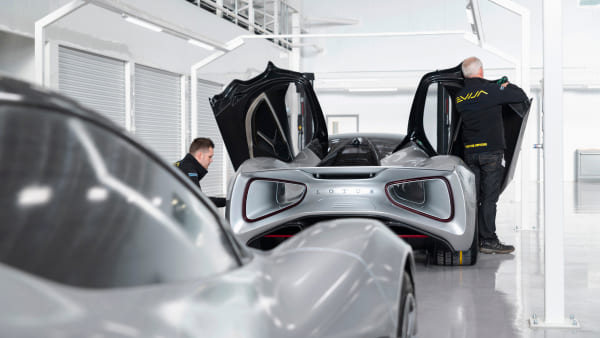

Lotus commits to an all-electric future.
2021
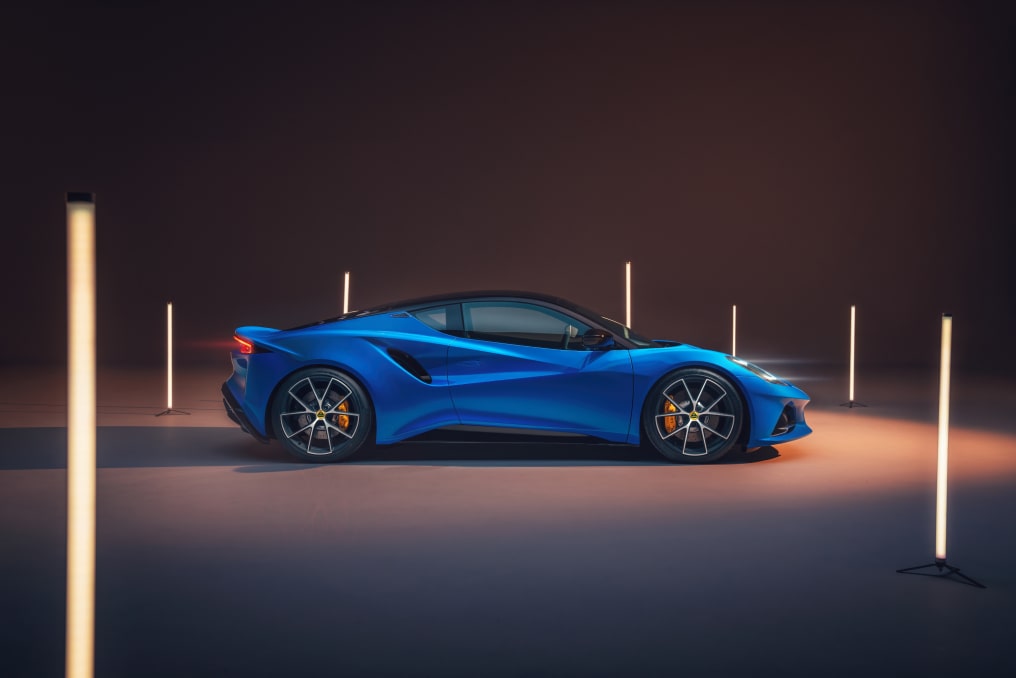
Lotus unveiled the Emira in July 2021, with a showstopping appearance at Goodwood Festival of Speed. The Emira marked the end of an incredible era – it is the last combustion engine car Lotus will ever produce. The Emira replaced the Elise, Evora, and Exige and shares design DNA with the all-electric Evija.
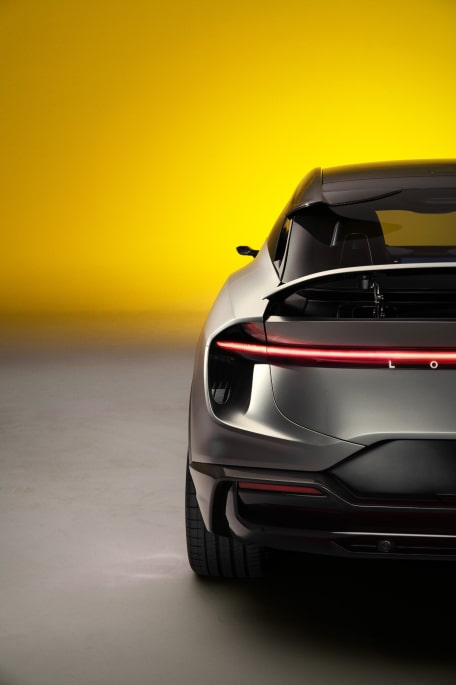
2022
Revealed in March 2022, the Lotus Eletre pionneers an entirely new category of cars. As the first-ever Hyper-SUV, the all-electric Eletre combines track-calibre performance, with everyday practicality and luxurious comfort.
Powered by twin electric motors, the Eletre can generate up to 900 bhp of power, with a high capacity battery providing up to 370 miles of range. Despite the spacious tech-enhanced interior, the Eletre is a true Lotus at heart, with classic Lotus driving dynamics and a lightning fast 0-60 mph time of under 3 seconds.1

2023
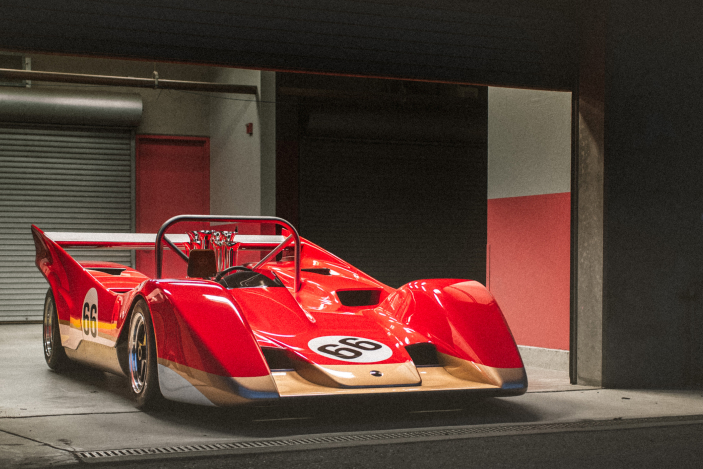
An archive venture championed by Clive Chapman, son of Lotus founder Colin Chapman, the Type 66 revives a 53-year-old ‘lost Lotus’ drawing board project. With an ultra-limited production run of just ten cars, this track-only masterpiece captures the theatre of motorsport, combining it with 21st-century performance and safety for the connoisseurs.
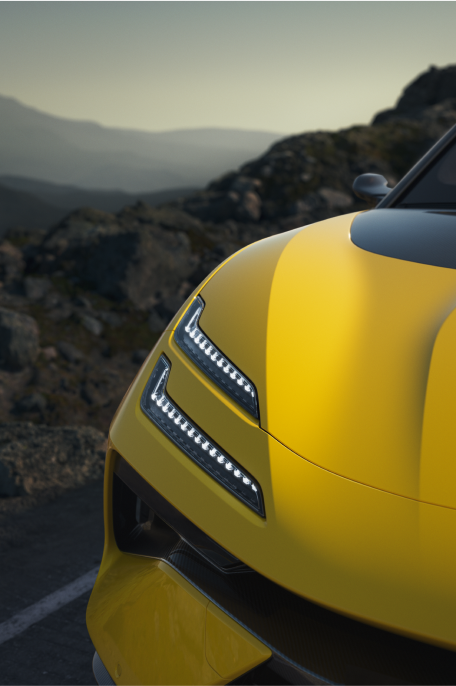
2023
Unveiled in New York in September 2023, the Emeya is our first Fully Electric Hyper-GT. Created to bridge the past and the future, Emeya combines thrilling sports car agility with GT refinement to deliver a refreshingly exhilarating drive.
The Lotus Emeya’s dual motor architecture provides 905 hp and 985 N·m of torque to facilitate a fierce 0-100 km/h in 2.78 seconds and a blazing top speed of 256 km/h.2
Capable of an 80% charge in just 18 minutes, fashioned from upcycled luxury fabrics, and fitted with next-gen systems and sound—this Hyper-GT delivers unparalleled driver-car connection and comfort.3
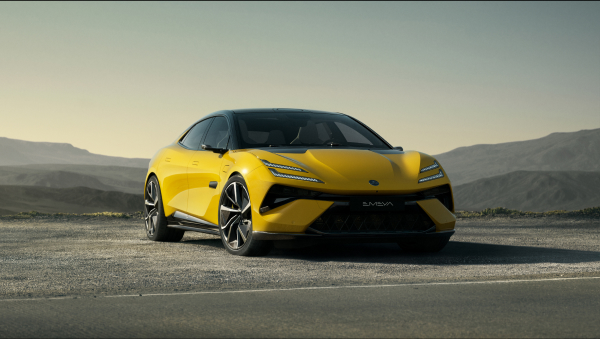
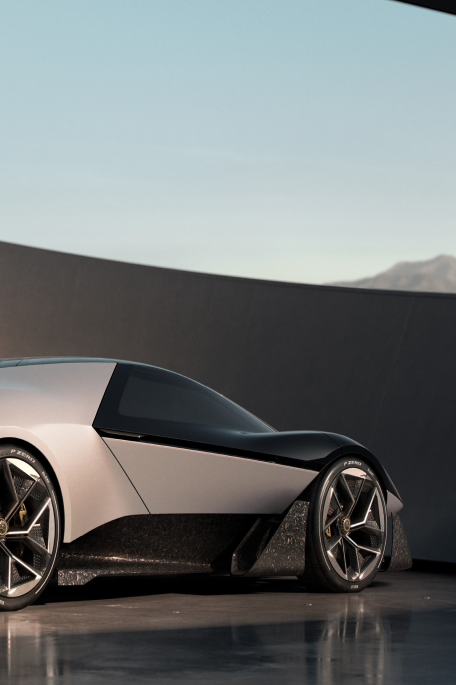
2024
An experimental concept car that embodies the future of intelligent performance.
Theory 1 is the first expression of our new design philosophy, based on three core principles: Digital, Natural, Analogue.
Our most famous Formula 1 cars inspired their anatomical design and central driving position in our ongoing pursuit of performance-driven engineering.With its cutting-edge technology, material saving and sustainability as its core values, it embodies our commitment to truly designing For The Drivers.
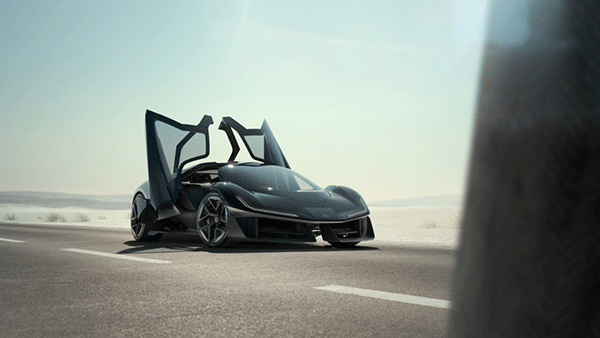
1. Target Figures - The vehicle specifications detailed on this page are target specifications based on simulations. Some of the model features, optional extras and colours shown may not be available, or may only be available in a different specification. The specified fuel consumption and emission data are determined in accordance with the measurement procedures prescribed by law. 1 January 2022, the WLTP test cycle completely replaced the NEDC test cycle and therefore no NEDC values are available for new type approved vehicles after that date. The range may differ in practice due to driving style, speed, load factor, outside temperature and topographical conditions. The charging time to be achieved in practice can vary as a result of external circumstances such as the type of charger, the condition of the battery and the temperature. Electricity consumption combined starting from 21,4 kWh/100 km; CO₂-emissions combined 0 g/km.
2. Target figure when equipped with Lotus Emeya R specification based on simulations. High performance features are not a substitute for driving safely with due care and attention. The driver should take extra care and drive responsibly.
3. When connected to 350kW DC fast charger in optimal conditions. The charging time may vary due to charger and battery type, age, condition, temperature, starting charge and environmental conditions. Charger availability is dependent on location.

YEAR OF BIRTH
Enter your birthday to discover what Lotus achieved in that year.